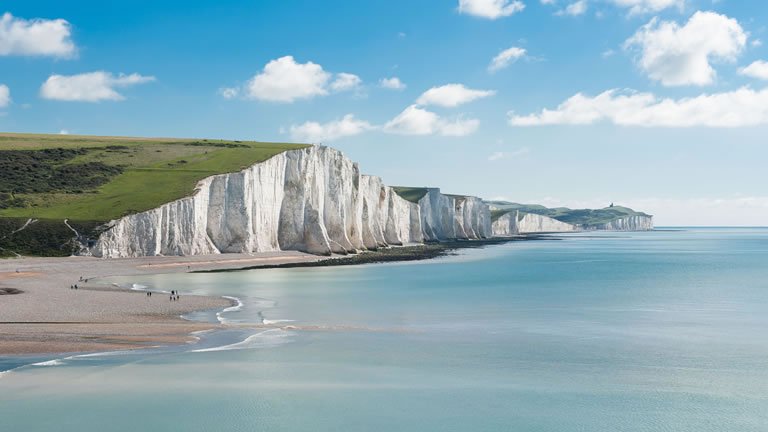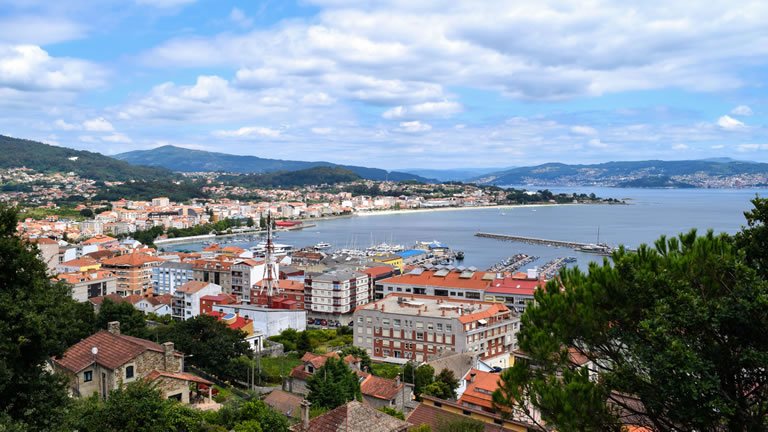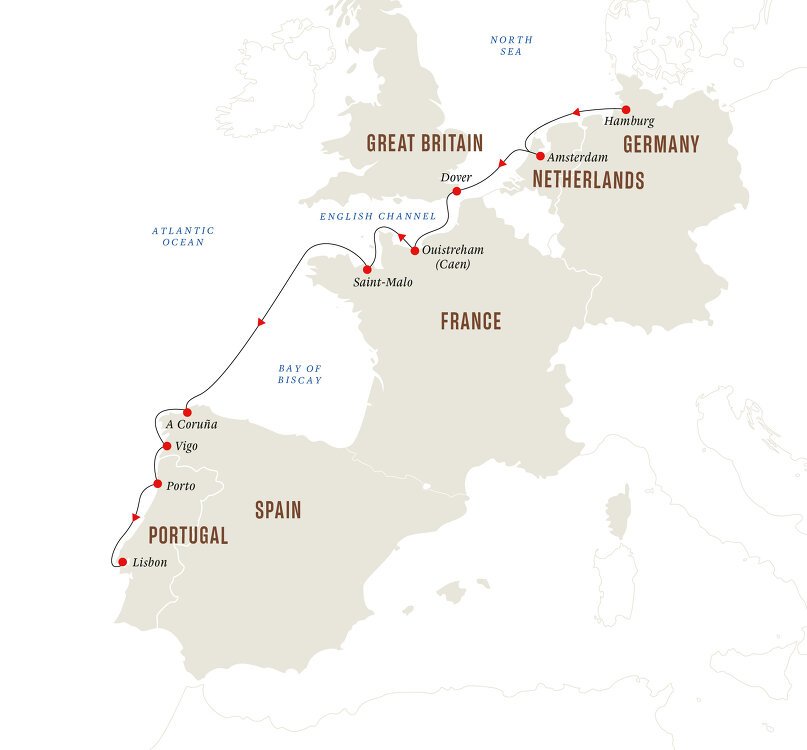Hamburg To Lisbon: Expedition Cruise Along Europe’s Historic Atlantic Coast
Overview
Itinerary
Your expedition cruise starts in Hamburg – and what a great place it is to set off from. The second-largest city in Germany is one of the greenest urban areas in Europe, boasting parks, botanical gardens and nature reserves. It also offers up fascinating history, plenty of culture and magnificent museums, as well as some excellent shopping options to buy those last-minute purchases.
Often called the ‘Venice of the North’, you can enjoy a boat tour to explore the city’s canals and harbour front. You can also easily explore on foot, by bike or by hop-on, hop-off bus.
Visit the old floating dock of Landungsbrücken, see the old ships and yards, waterfront buildings, and the Old Elbe Tunnel. Climb the 433 ft. bell tower of the famous St. Michael’s Church for stunning views over the city.
Many places of interest are concentrated in the Altstadt or Old Town. Visit St. Catherine’s Church and the St. Nikolai Memorial. Discover the timber-framed houses of Deichstraße Historic Street and see the impressive City Hall on Rathausmarkt Square.
The world’s largest warehouse complex at Kontorhausviertel and Speicherstadt, which together with Chilehaus, are all UNESCO World Heritage Sites. If you must choose just one museum to visit, Hamburg Kunsthalle ranks as the nation’s best art museum. You can break up the sightseeing with some browsing on Mönckebergstraße, or stop for some traditional Hamburger fare like aalsuppe, a ham soup with dried fruits, or labskaus, corned beef with potato and pickles.
Later, your comfortable expedition ship MS Spitsbergen will be waiting for you at the port. Find your cabin and attend a mandatory safety demonstration as we prepare for the journey ahead. After a welcome dinner, where the Captain will toast our journey, you can sink into an armchair in the Explorer Lounge & Bar with a glass of your favourite beverage and relax – your expedition is underway!
Pre-ProgrammeIf you have time prior to embarkation, Hamburg is definitely worth spending some time getting to know. We recommend booking our optional Pre-Programme, which includes a city tour taking in the main sights of this modern yet historic city. Also included is a visit to the amazing Elbphilharmonie concert hall’s observation deck.
Today we’ll sail south, following the outer coast of the Frisian Islands as we head towards the Netherlands. These sandy islands form a low-lying archipelago that fringes the eastern edge of the North Sea. Whilst many of them are populated, being mostly sandbanks, the Frisian Islands are constantly reforming and reshaping.
Our onboard Expedition Team will start their lecture programme, giving talks in the Explorer Lounge and offering their insights into the history, heritage, and natural science of our upcoming destinations. Why not follow our biologists onto the outdoor decks as they scan the seas for wildlife.
Now’s also the perfect time to really get to know the ship and all its facilities. As our journey gets underway, you might also want to spend some time getting to know the crew and your fellow explorers. Strike up a conversation at the bar and see what you have in common with your shipmates, or relax in a comfortable chair by a window and watch the sea peacefully pass by – it's totally up to you!
Today you’ll get to wander the quaint cobbled streets and see the reflective canals of Amsterdam – the city where the land meets the sea. The Netherlands’ famously liberal capital is a showcase of architectural styles, and it’s saturated in history.
Founded in the Middle Ages, Amsterdam is a cosmopolitan city with a rich cultural heritage. Located at the estuary of the river Ij, the original settlement was built on islets of moving sand linked by a thousand bridges. Today, water remains all pervasive and it’s still is a city that looks to the sea.
The concentric, semi-circular rings of canals found in the original core of the city look somewhat like a spider’s web on the map. All streets and bridges seem to spread radially from Singel, the inner city and the oldest part of Amsterdam. It’s a good idea to begin exploring here and then continue later with the western and eastern canals.
Walk around beside these iconic canals and across the old bridges between the rivers Amstel and Ij. You’ll probably come across the charming townhouses lining the canals of the Grachtengordel. They were built in the 17th and 18th centuries by wealthy merchants, and are now protected by UNESCO.
Head over to Museumplein, where three of the world's top museums await you. The Rijksmuseum has one of the greatest European galleries, known for its unrivalled collection of Dutch masters, including Rembrandt. Meanwhile, the Vincent Van Gogh Museum has the world’s largest collection of the troubled genius’s paintings, while the Stedelijk Museum is one of the best places to view modern art.
If you’re tired of walking, you could go on one of the many canal boat tours on offer. There are many different operators, and some provide a hop-on-hop-off service at the main sites.
Located facing the narrowest stretch of the English Channel and flanked by spectacular chalk cliffs, Dover has been the gateway to Britain since prehistoric times. Founded during Roman times, the settlement of Dover quickly became the main port between the provinces of Britannia and Gallia Balgica, and its strategic position has remained important ever since.
Start your day with a visit to the sprawling Dover Castle, with dazzling views of the Channel, just a short walk from the port. If you’re a history buff, you won’t be disappointed by this huge fortress. Admire the Roman lighthouse, the 13th century gates and the massive outer defences built during the Napoleonic Wars.
You might want to pay a visit to the underground barrack tunnels that served as the fire command post during the Great War, and later as the headquarters of Admiral Sir Bertram Ramsay during the evacuation of French and British soldiers from Dunkirk in 1940.
If you haven’t had your fill of historical sites, make your way to Dover’s only remaining Norman church, the 12th century St Mary’s, which survived the heavy bombing of WWII. Or explore another medieval building that survived the war, the 13th century Hospital of St Mary, also known as Maison Dieu, and now part of the Town Hall.
The Western Heights of Dover are worth a visit if you’re looking for more fortifications to explore. Within walking distance from the port, these vast defences are made up of forts, strongholds and ditches built in the 18th and 19th centuries.
Of course, don’t miss the opportunity to snap the perfect shot of the iconic White Cliffs of Dover, just east of Dover Castle. Continue eastwards to the South Foreland Lighthouse for magnificent views or explore the picturesque St Margaret’s Bay, four miles away.
With a rich and turbulent past, Normandy is a region inextricably tied up with European history. From the Viking Rollo’s arrival in 911, to being the seat of the Norman invasion of England by William the Conqueror in 1066, and the D-Day landings in 1944, Normandy is a captivating mix of medieval abbeys, sprawling beaches and moving WW2 memorials. Ouistreham is known for its D-Day landing sites in connection with Operation Overlord. A 50-mile stretch of the Normandy coast was sectioned into five areas, with Ouistreham codenamed Sword. The invasion here was the responsibility of the British Army, with backup from the navies of Norway and Poland. Learn more about the landings and the heavy battle that was fought here at the Musée de Debarquement No 4 Commando.
Visit the extensive German fortifications at the restored Grand Bunker Mur de l’Atlantique Musée, dedicated to the Atlantic Wall, and pay tribute to the fallen at the war cemetery of Hermanville-sur-Mer, three miles west of Ouistreham. Afterwards, stroll along the beautiful Riva-Bella beach and feel the salty Atlantic breeze. You might also enjoy a visit to the nearby 12th century church of St Samson and the 1905 lighthouse. Located 11 miles from Ouistreham, Caen was named Catumagos by the Romans after a Celtic term for battlefields. Fortified by William the Conqueror, who preferred it to Rouen, the city changed hands repeatedly and was occupied several times. Despite being heavily bombed during WW2, Caen was rebuilt and has retained its considerable charm. Don’t miss the impressive 11th century Romanesque church of Saint-Étienne.
Stroll the pleasant streets and take in the small shops, pavement cafés, green parks and restaurants. If you appreciate fine art, you’ll enjoy the Musée des Beaux-Arts housed in the remains of the Château de Caen.
Viewed from the sea, Saint-Malo is quite a sight. This gateway to Brittany is fringed by fortified bastions and shallow beaches, creating the impression of a place apart. In fact, Saint-Malo considered itself an independent city state for much of its modern history, and its residents still refer to themselves as Malouins, somewhat distinct from the French and even the Bretons.
Whatever you do today, make room for a circular walk of the ramparts. From the top of the walls, you’ll have the best views of the town and the surrounding islands. You’ll find tributes to Saint-Malo’s most celebrated locals: a statue of famous pirate Robert Surcouf and a monument to Jacques Cartier, the maritime explorer credited with mapping the Gulf of St. Lawrence and naming Canada.
The corsairs of Brittany were ruthless privateers, operating under the protection of the King of France. Back home in Saint-Malo, they built fine country homes and were treated as respectable gentlemen. Tour the Château Saint-Malo museum and visit the Privateers House, where you can learn about the town’s pirate heritage.
At low tide, walk across the sand to the fortified island, Le Grand-Bé, where famous 19th century writer Chateaubriand is buried, then gaze across to the Vauban-designed bastion of Fort National on a nearby island.
Within the old city walls, a historical trail leads through a maze of cobbled streets where you can discover what remains of the original town before the Allied bombings of 1944 reduced much of it to rubble. Visit the Gothic-style St. Vincent Cathedral and the Chateau de la Duchesse Anne, with its distinctive turret.
Then take a scenic stroll to the nearby village of Aleth, where you can discover more about Saint-Malo’s experiences during World War II at the Cap-Horniers Museum.
Today we’ll enjoy a leisurely day at sea as we sail across the western edge of the Bay of Biscay on our way down to Spain’s Galicia region.
Back in the days of the Romans, these waters were named Sinus Cantabrorum after the Cantabri, the Celtic tribe inhabiting the northern coasts of the Iberian Peninsula. Today, the southern portion of the Bay of Biscay, adjacent to the northern Spanish coast, is still called the Cantabrian Sea.
Relax on deck with your binoculars and look out for wildlife. Cetaceans can often be spotted here, with up to a quarter of the world’s species of whales, dolphins and porpoises having been recorded in the waters of the Bay. They are drawn here by the nutrient rich waters around the edge of the continental shelf, and it’s one of the few places in the world where beaked whales can be seen, if you’re lucky.
If you haven’t already done so, now could be a good time to get to know the onboard Science Center. Here you’ll have plenty of information at your fingertips and you can learn about the marine biology of the seas along our cruise. There are hands-on demonstrations to take part in, high-tech microscopes to view marine microorganisms, and nature photography tips to learn.
Join the Expedition Team in the Explorer Lounge for in-depth lectures on different topics related to the days ahead. These might include learning about the history, geography, and the environment of the destinations to come. And don’t forget to make full use of the leisure facilities on board MS Spitsbergen – why not try out the panoramic sauna if you haven’t done so yet?
We continue our Atlantic journey across the Bay of Biscay, towards Finisterre, the ‘Land’s End’ region of north-western Spain. Despite its apparent isolation at the edge of the Iberian Peninsula, Finisterre and the rest of the Galicia region have played a central role in Atlantic Europe since prehistoric times.
Ships sailing to and from the Mediterranean had to navigate the rugged Galician coast and seek shelter from the occasional fury of the ocean in the natural rias. Fjord-like in appearance, these rias are not flooded glacial valleys like the Norwegian fjords, but river valleys flooded after the last glaciation. Their gentle banks hold an age-old allure and are the reason why farming and fishing have thrived in this region.
The oldest extant lighthouse in the world that’s still functioning, known as the Tower of Hercules, bears witness to this enduring relationship with the sea. Built around 2,000 years ago in Roman times, the tower of A Coruña has survived to this day and helps ships navigate the tricky Finisterre coast of Spain and safely enter A Coruña’s natural harbour. The lighthouse has been a UNESCO World Heritage Site since 2009.
We expect to dock at A Coruña in the evening, giving you plenty of time for a leisurely stroll into town from the port and a chance to visit the unique lighthouse. Galicians, it has long been claimed, are among the toughest fishermen in Spain, and their maritime heritage still permeates many aspects of life here, as you will discover as you explore.
A Coruña is one of the main cities in Galicia, a region of Spain that’s culturally distinct and with its own identity. With a dialect that’s closer to Portuguese than Spanish, Galicians are proud of their Celtic roots.
Settled by Celtic peoples from at least the first millennium, A Coruña flourished under the Romans. It was conquered during the Arabian Invasion at the beginning of the eighth century and reconquered shortly after by soldiers under Christian command. As if that wasn’t enough, A Coruña was also repeatedly attacked by Vikings in the ninth and tenth centuries.
Today, the historical centre is an enticing mix of charming squares, winding streets and narrow alleys. The perfect city for exploring on foot, it’s also home to ancient chapels, Baroque convents, and plenty of neoclassical architecture. Stroll through the old town and admire the famous glass-fronted buildings by the harbour, and don’t miss the architectural structures at Plaza María Pía and the archaeological museum located at the old castle.
If you didn’t manage to see the Tower of Hercules yesterday evening, be sure to do so today. After your wanderings, have a rest at one of the many bars or restaurants, and sample the unique gallego cuisine. Ask for a selection of tapas, which might include the classic pulpo a la gallega – Galician octopus – and sample a glass of famous Galician cider, traditionally poured into the mouth from a height.
A Coruña is an excellent base from which to explore the highlights of Galicia, including the UNESCO World Heritage Sites of the Roman walls of Lugo and the pilgrimage city of Santiago de Compostela. Join one of our optional guided tours to explore these two major sites.
Perfectly sheltered inside a ria, and protected by the beautiful Cíes Islands, Vigo has one of the best natural harbours in Galicia. The city flourished in the 16th century, attracting traders and settlers, as well as pirates and other invaders. But Vigo persevered and grew to become the main trading and fishing port of Galicia.
For centuries, Vigo was the gateway to the Americas. Many Galicians, as well as other Spaniards, emigrated to the New World from here. Even today, in many Latin American countries, people of Spanish descent are sometimes known as Gallegos, regardless of where in Spain their ancestors came from.
Vigo expanded eastwards in the 19th and early 20th century along the bustling Rúa do Príncipe with an eclectic mix of buildings in neoclassical and Art Nouveau styles. Perhaps the most impressive structure of all, is the 16th century Castro castle and its surrounding park with spectacular views of the town. Nearby, you’ll find the remains of an iron age castro, the original settlement of Vigo from more than 2,000 years ago.
The port is perfectly located for exploring the city on foot. Vigo is built on the slope of a hill overlooking the ria, which means that almost everything is uphill from the harbour! The maze of streets in the old town are organised around Plaza de Igrexa and the 19th century neoclassical cathedral of Santa Maria.
On your way to the square and the cathedral, stop by Rúa da Pescadería, the best street in town to sample the delicious seafood Galicia is famous for. After that, have a coffee break on the Praza da Constitución, a lovely square with pretty houses, cafés, and restaurants.
MS Spitsbergen will dock at Leixoes, an excellent first base in Portugal for a spot of exploration. Head north towards the small fortification of Forte Leça de Palmeira and continue along the beach to Avenida Liberdade, or visit the Lighthouse of Leça, the Chapel of Boa Nova, and the beautiful Praia Azul beach.
A shuttle bus is available take you the six or so miles to Porto. Famed for its port wine and UNESCO-listed historic centre, Portugal’s second city will win you over with its charismatic looks and surprise you with its modernity. It’s a place made for strolling, with a maze of narrow streets and unique monuments, and where everywhere eventually seems to lead to the Douro River.
Don’t skip the Church of San Francisco, the Romanesque cathedral with an opulently gilded Baroque interior, or the panoramic views from the top of the Church of the Clérigos. Do you like books? Lose yourself among the magical neo-Gothic interior of the beautiful Lello bookstore, and afterwards discover the Palácio de la Bolsa and stroll along Avenida de los Aliados.
Soak up the atmosphere along the bustling riverside promenade at the Ribeira Docks, packed tight with pastel-coloured houses and beautiful tiled façade. Cross the Douro via the top deck of the Eiffel Tower–inspired Ponte de Dom Luís I bridge, see the warehouses and port cellars of Vila Nova de Gaia on the south bank, and cross the bridge again, this time along the lower walkway.
Reward yourself afterwards with a refreshing glass of white port and tonic at one of the many lively bars and restaurants on the pier. Built up an appetite? Try Porto delicacies like the francesinha – a popular grilled meat and cheese sandwich – and the local variant of salt cured cod, called bacalhau.
We’ll be sailing south all morning, so why not join the Expedition Team for more fascinating talks, or head out on deck to scan the sea for marine life. We expect to arrive in Lisbon in the afternoon, so get ready to discover the ultimate destination on your cruise.
Located close to the Old Town, Lisbon Cruise Terminal is perfectly situated to explore the historical centre of the Portuguese capital on foot. Built on seven hills along the shores of the scenic River Tagus, Lisbon ranks among southern Europe’s most enchanting cities — with a fascinating history to boot.
The Phoenicians were the first to discover the commercial potential of the Tagus Estuary, but not the last. Lisbon’s great strategic location attracted the Celts, Romans, Visigoths, and Moors, each of whom occupied the city and left their mark.
A walk around Baixa, Bairro Alto, and Alfama, the classical districts of Lisbon, is essential. Almost everything of historic interest is here, as well as a great number of small shops and boutiques. Start at the Praça do Comercio in the Baixa district and make your way to Praça Rossio to see the statue of King Pedro IV before heading up to Largo do Chiado to explore the narrow streets of Bairro Alto.
In Alfama’s labyrinthine streets around the old Islamic quarter you’ll find Lisbon Cathedral; the remains of the Roman amphitheatre; and Castelo de San Jorge, the impressive 11th century Moorish fortress, which offers the best views of the city.
There are two historical gems you must leave the centre to see. Follow the river just over four miles downstream and visit Torre de Belém and Mosteiro dos Jerónimos, both UNESCO World Heritage Sites. Closely connected to Portugal’s Age of Discovery and explorers such as Vasco de Gama, Belém is also home to the famously delicious Pastel de Belém custard tart – which you’ll definitely want to try!
Our expedition cruise ends at Lisbon. After breakfast it’ll be time to bid a fond farewell to MS Spitsbergen and all those who made your expedition so memorable, including the Expedition Team and other crew members.
Post-ProgrammeWe feel sure that you’ll have had a great cruise discovering the fascinating history of the Atlantic coastline of Europe, but you don’t need to go home just yet. If you would like to explore Lisbon and its surroundings before you return home, we recommend joining our optional Post-Programme.
Not only will you see Lisbon’s fascinating historic districts, you’ll also explore the royal resorts outside the city, including the UNESCO town of Sintra, Monserrate Palace and the beaches of Cascais city during a guided excursion. Afterwards, you’ll return to Lisbon where you’ll spend the night.
As you return home, no doubt you’ll already be planning your next adventure. We look forward to welcoming you on board again soon!
Life Onboard MS Spitsbergen

Intimately scaled and perfectly designed to take the scenic route; enjoy open viewing spaces and Scandinavian touches. Read more

Destinations come to life with a Guide Team on classic coastal voyages and an Expedition Team on expedition sailings. Read more

From cosy inside cabins to luxurious suites, the perfect home away from home awaits for every cruiser. Read more

Enjoy a delightful menu crafted from fresh ingredients and locally sourced produce served up in the main restaurant. Read more
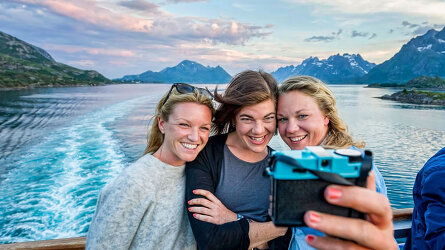
Enjoy Hurtigruten's famously relaxed atmosphere and cruise comfortably day and night, with no need to change for dinner. Read more

Make use of the wellness and recreation facilities on board, including a gym, sauna, and outdoor hot tubs. Read more
Availability Click on prices below to view cabin upgrades and details
Tour & cruises prices are per person. Prices shown have savings applied, are subject to availability and may be withdrawn at any time without notice. Prices and trip information are correct at the time at this point in time, however are subject to confirmation at the time of booking and are subject to change by Hurtigruten. For cruise itineraries, cabin images are sourced from Hurtigruten. These should be treated as indicative only. Cabin inclusions, upholsteries and room layout may differ to the image(s) shown depending on the ship selected and your sailing dates.
Similar Cruises

14 Days Lima Valparaiso
Operated By: Hurtigruten

14 Days Bergen Oslo
Operated By: Hurtigruten
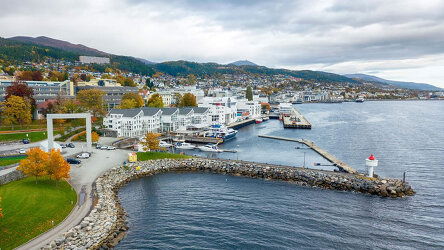
14 Days Oslo Bergen
Operated By: Hurtigruten
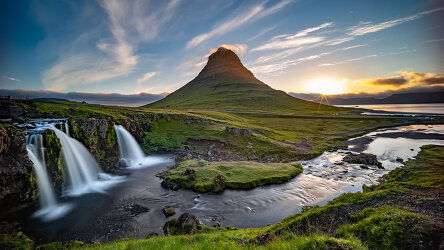
14 Days Glasgow Oslo
Operated By: Hurtigruten

